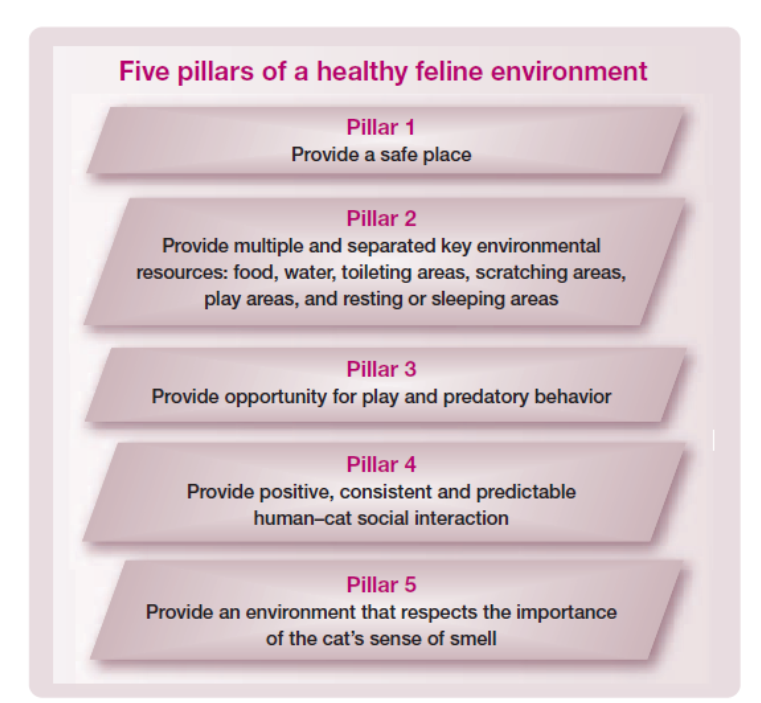
5 Pillars to Ensure a Healthy Environment for Cats
 Providing a cat with a comfortable environment is linked with better physical, emotional, and behavioral health. All cats have the same essential environmental needs. Unfortunately, many cats live in homes that are missing some key elements and this results in stress-related disorders as well as unwanted behaviors.
Providing a cat with a comfortable environment is linked with better physical, emotional, and behavioral health. All cats have the same essential environmental needs. Unfortunately, many cats live in homes that are missing some key elements and this results in stress-related disorders as well as unwanted behaviors.
Additionally, many cats can’t cope well in multi-cat households if their environmental needs aren’t being met. Thankfully, the American Association of Feline Practitioners and International Society of Feline Medicine have developed the following guidelines on the five pillars of a healthy feline environment to help cat owners and veterinarians meet these needs.
Pillar 1: Provide your cat with a safe place
Your cat’s safe place is a private area that provides him with a sense of security. It helps if this area is raised, which allows your cat to observe his environment, retreat, and feel protected. Options for safe places include cardboard boxes (which cat doesn’t love these?), perches or shelves, and even his carrier. If your cat is currently frightened of his carrier, it may need to be left out for a while to become part of the “furniture.”
Pillar 2: Provide your cat with multiple and separated key resources
Your cat’s key resources include her food, water, litter boxes, scratching areas, resting/sleeping areas, and elevated areas such as perches. Provide these in multiple locations to provide your cat with several choices. If you have multiple cats, provide these resources in multiple locations to help minimize competition, bullying, and social stress.
Pillar 3: Provide your cat with the opportunity for play and predatory behavior
Cats are active predators, and when given the opportunity to hunt outdoors will spend a significant amount of their day in hunt-related activities. Even well-fed cats will stalk, chase, and kill prey. Unfortunately, if you don’t provide your cat with opportunities for predatory-behaviors, he may become obese, bored, and frustrated. He may develop a stress-associated disease or respond aggressively toward you and other animals within your household. Thankfully, there are many options to provide even indoor cats with the opportunity for play and predatory behavior. Options include toys, regular play with you, and feeding toys that require him to actively acquire food.
Pillar 4: Provide your cat with positive, consistent, and predictable social interactions
All companion animals, including cats, benefit from regular, positive, consistent interactions with their human family members. Your cat will experience less stress when allowed to choose whether or not to interact with you, rather than having interactions forced upon her. Allow your cat to approach you rather than approaching her. If your cat appears relaxed and wants to interact, it’s best to focus petting around the head and cheeks. When your cat moves away, don’t force further contact by following your cat or picking her up.
Pillar 5: Provide your cat with an environment that respects the importance of his sense of smell
Cats depend much more on their sense of smell than we humans do. Your cat’s sense of smell provides him with important information, helping him to both detect potential threats and feel secure in his environment. Your cat marks his environment with pheromones by rubbing or scratching objects. These pheromones establish his core living area—where he feels most safe and secure—and communicate with other cats. Whenever possible, avoid interfering with your cat’s sense of smell. This includes avoiding use of strong cleaners, detergents, and scented litter and providing scratching posts or boxes.
This article gives you a brief overview of the five pillars of a healthy feline environment. If you have questions on your cat’s specific needs, please contact your veterinarian or veterinary behaviorist for assistance. You can also visit the University of Illinois at Urbana-Champaign, College of Veterinary Medicine website to review articles where Dr. Ballantyne has covered each pillar in more detail.

